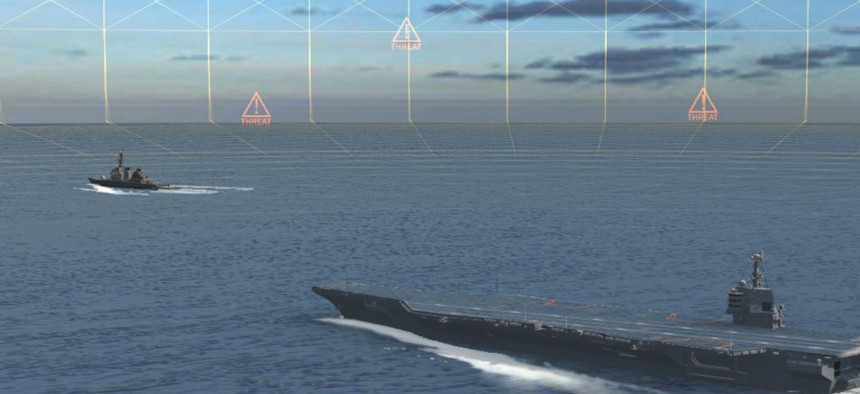
BAE to demonstrate next-gen EW detection for the Navy
ONR wants the company to show continued proof-of-concept development in electromagnetic spectrum emitter detection and situational awareness.
As part of an ongoing research effort, the Office of Naval Research has awarded BAE Systems an $11 million contract for work on a next-generation, wideband electromagnetic spectrum detection system.
BAE’s Full-Spectrum Staring Receiver enables near-instantaneous situational awareness, emitter tracking, threat warning and countermeasure cueing for ships and aircraft.
The contract award falls under ONR’s Electronic Warfare Discovery and Invention Program, which seeks to develop and demonstrate a broad range of next-generation EW systems that exploit, deceive or deny enemy use of the electromagnetic spectrum while ensuring unfettered use of the spectrum by friendly forces, BAE said in an announcement.
ONR’s Electronic Warfare Discovery and Invention Program has been ongoing for many years, Steve Hedges, FSSR principal investigator at BAE Systems, told Defense Systems, and is a program portfolio that is looking at proof-of-concept developments as well as exploring what’s possible in terms of technology. Hedges said that, over the last decade, ONR has been using the program to improve electronic components.
Given that ONR’s program is research and development based, FSSR has not been operationally deployed yet. “We’re still developing technology and demonstrating proof of concepts,” Hedges said, declining to offer a timeline for operational capability or go into many details about the research. Hedges did, however, say the Navy’s interest is in situational awareness and that electromagnetic spectrum monitoring is rooted in knowing where signals might be coming from.
“I am particularly excited by this research effort, because it integrates a number of electronic warfare technologies that have been advanced by ONR-funded efforts dating back to 2008,” said Dr. Peter Craig, electronic warfare program officer for ONR. “Even more gratifying is that it brings together the talents of researchers from academia, industry, and the government in a coordinated effort that will benefit not only the Navy but the entire Department of Defense community.”
Other members of BAE’s FSSR team include the S2 Corporation, University of Colorado Boulder, Montana State University, Purdue University, HRL Laboratories and the Naval Research Laboratory.
“The goal of our program really is to integrate a collection of component-level technologies that ONR has funded over the past decade and show that those component technologies really…are enablers for system capabilities for the future,” Hedges added.